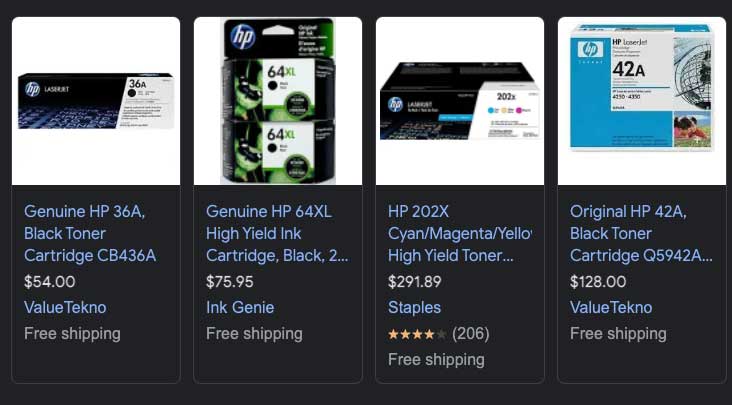The reason why ink cartridges are so expensive?
The Problem with Ink Cartridges...
When it comes to printers, most people think that the prices of the ink cartridges are outrageous. In some cases, they can be up to $50 for a single cartridge! But what if there was a way to get around those high prices? InkRestock is a website that is aiming to do just that. They are creating a massive search for the best deals on OEM ink cartridges, so that you can save money without having to compromise on quality. Check it out today and see how much money you can save!
Here's a quick and simple answer: printer ink is expensive so companies can make a profit. MOST printers are sold at losses, but there’s money to be made not in selling consumers an “inkjet" or laser printer—but rather providing all the supplies needed for printing! The manufacturer controls exactly how much it will cost you per page (and their prices vary).
Fact:
Printers are basically FREE these days...
The printer industry is built on a basic business paradigm. All companies operate under the same principle: make less money in retail sales, but more from replacement supplies over time thanks to their ink plans which are always costly as they charge you by pages printed instead of per piece like other manufactures do ( Brother HP Epson Canon etc). Manufacturers of printers use a business model known as "razor blade" in order to make a profit. This involves selling the printers at low prices, often below cost, in order to attract consumers. The manufacturers then make their profits by selling the expensive ink cartridges that are necessary for the printer to function. This business model is effective because the overwhelming majority of consumers will stick with using genuine OEM (original equipment manufacturer) products, rather than opting for less reliable remanufactured or compatible third-party products. As a result, the manufacturers are able to make a profit off of the sale of ink cartridges, even though they may lose money on the initial sale of the printer.
Expensive ink cartridges are one of the many ways printers trap consumers into a never-ending cycle of overspending. These cartridges can cost upwards of $100 apiece, and they need to be replaced frequently in order for the printer to function properly. As a result, consumers who opt for genuine OEM cartridges often find themselves spending hundreds or even thousands of dollars on ink every year. Even worse, many printer manufacturers design their products in such a way that it is difficult or impossible to use third-party or remanufactured cartridges. This forces consumers to either continue paying high prices for ink or else purchase a new printer entirely. It’s no wonder, then, that the “razor blade” business model is so profitable for printer manufacturers. By selling printers at low prices and then trapping consumers into buying overpriced ink cartridges, these companies are able to keep their profits high and their customers locked in.

Fact:
Ink Cartridges Are Designed To be defective
Small cartridges are designed to break. It's a fact. And, it's not just printers. Televisions, smartphones, and other electric devices have a lifespan too. Electronics companies can build products that last for decades, but where is the profit in that? We live in an age of disposable electronics and, unfortunately, those electronics are often filled with potentially hazardous materials. So, what can we do? We can recycle our electronics responsibly. We can bring our old devices to certified e-waste recycling facilities or manufacturers who will properly disassemble and recycle them. By recycling our electronics, we can help reduce the amount of hazardous waste in our landfills and prevent harmful toxins from leaching into the environment.
FOOD FOR THOUGHT:
Why is this happening? So we have to buy more. We live in an age of disposable electronics and it is not good for the environment. All those plastic parts eventually find their way into the landfill where they will sit for centuries before decomposing. And, not to mention, the small electronics are often filled with potentially hazardous materials that can leach into the ground and contaminate the water table. Here's a better idea: Buy a printer that uses refillable cartridges. You'll save money and help the environment too.

Fact:
Brands like HP and Canon charge you a lot for "technology"
The inkjet printing technology has come a long way since its commercial debut in the late 1970s. The first inkjet printers were large, expensive, and slow, and their ink cartridges were prone to clogging. However, inkjet technology has rapidly evolved, and today’s inkjet printers are smaller, cheaper, and faster than ever before. Thanks to ongoing research and development, ink cartridges have also become much more reliable. The chambers inside ink cartridges have a thin filament running through them. When the filament is heated, the ink bubbles, and the buildup of pressure propels a droplet from the ink cartridge, through the print head, and onto the paper. This process is repeatable and reliable, making it possible for even the most budget-friendly inkjet printers to produce high-quality prints.
ADVICE:
Genuine OEM ink is still the best value and quickest option for printer owners, but with brand and new technology comes more expensive items.
Conclusion
It’s no secret that printer ink is expensive. In fact, it can be downright outrageous at times. But what may come as a surprise is how much money is actually spent on ink cartridges every year. Did you know that the price per gallon for printer ink ranges from $1,664 to an astounding $9,600? And globally, we spend over $20 billion on ink cartridges annually! While there are many reasons why printer ink is not cheaper, it doesn’t stop us from wishing for a more affordable option now and then. So tell us, Is Printer Ink Overpriced? Share this article with your team and see what they think.
- InkRestock Team
